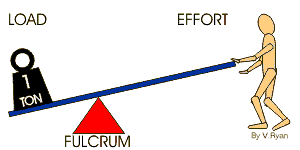What if I gave you a lever arm to multiply your time by 10x, 20x, or more? You could work for just an hour, but get a full day’s free time? Would you be interested?
Give me a lever long enough and a fulcrum on which to place it, and I shall move the world.
Archimedes

My friend JRod triggered this great brainstorm back in October. (PS – You can hear JRod’s story on Episode 33 of The Best Interest Podcast.)
These words strike at one of my favorite concepts: the trade-off between time and money.
Both time and money are valuable resources. But more importantly, they are intrinsically connected.
We convert our time into money throughout our lives. We call it “work.”
And while we can’t reverse that conversion—that is, we can’t buy more years in which to live—we certainly can buy time freedom. We can buy a future where we don’t have to work as much. This is the essence of the FIRE movement.
Money is the medium that allows us to trade our time for…well, for anything. We can trade our time for food, for clothes, for shelter. We can even trade our time today for time in the future. That’s the point that JRod makes.
And how do we trade time now for time later?
Through investments.
Our investments act as multiplying vehicles. As lever arms. Give up some time today: work, get paid, then buy investments). Eventually, redeem your time freedom in the future: sell investments, get money, use that money to live.
The challenge, of course, is determining how much time you’re willing to give up today. We’ll get into this at the end of the article.
But first, let’s look at a little fun math.
The Math of Multiplying Your Time
Meet Kolin. He earns $60,000 per year. And Kolin spends $3600 per month. That’s $120 per day. Or $5.00 per hour. Or $1 per 12 minutes.
$1.00 = 12 minutes
This is just one way of measuring the value of Kolin’s time. His lifestyle costs $1.00 per 12 minutes.
But investing gives us another option. Investing lets us multiply that ratio and apply it to Kolin’s future. Investing provides the proverbial ability to “bury a small acorn to let a giant oak grow.”

Kolin can bury his extra dollars today and let them grow into a huge money tree. How big will this tree grow?
Let’s use a classic retirement timeline: Kolin saves and invests for 30 years of growth at 7% per year. Thus, he will turn $1.00 today into $7.61 in the future.
**Note: the 7% return is calculated starting with a 10% average rate of return from the S&P 500 and subtracting 3% for annual average inflation. So yes – this figure accounts for inflation. But keep in mind—actual returns are not the same as average returns.
7.61x is quite a multiplier.
Today, Kolin spends $1.00 every 12 minutes. But if Kolin invests instead, that same dollar buys him 7.61x more time freedom in the future, or 91 minutes.
Another way to look at the numbers: Kolin could take his surplus dollars today (earning $5000/month – spending $3600/month = $1400 surplus) and invest them. After applying our 7.61x multiplier, those $1400 would be worth $10,654. That’s enough to fund 3 months of spending in Kolin’s future.
No extra effort was needed. Kolin didn’t need to bust his ass to buy those additional 79 minutes. He didn’t need 3 months of work to fund those 3 months of future living. Kolin simply worked today, invested, and waited. Patience is a virtue.
In a nutshell (acorn?), this is the main reason to invest. You can multiply today’s effort into future time freedom.
Spending Today vs. Investing Today
“Nothing is more self-limiting than going to extremes.”
– Marty Rubin
How much should you spend today? How much should you save and invest?
The answer is different for each of us. But following Marty Rubin’s advice is a good place to start. You shouldn’t invest nothing. You also shouldn’t invest everything.
The two most common “investing regret” stories I read on forums like Reddit go like this:
Story #1: I’m 50 years old. I’ve spent every dollar I’ve ever earned. We have a big house, nice cars, and my kids always had the nicest stuff (even petty material junk). But I have nothing saved for retirement. I’m worried I’ll have to work until I die.
Story #2: I’m 34 years old. I have worked my ass off at an elite job, and barely spent any money so I can invest it all instead. I have 50 years of life ahead of me…but no friends, no partner. I’ve never had any hobbies other than work. All the fun stuff that people do in their 20s…I didn’t do any of it. I could retire today, but I’m scared of the barren life that I’m retiring too.
Do you want to be either of these people? I don’t. So when it comes to time vs. money, avoid the extremes.
Build a life that you want to live and save the money to actually live it.
How much building? How much saving? I can only answer that for myself.
I lean towards the saving side (here’s how I invest). But I also love spending money on the biggest, best experiences in life. I call this bimodal spending.
And as I wrote last week, the spending that I’ll have to do in the next few years is a bit stressful. I think one reason why it’s stressful is that I’ll have to temporarily re-balance my saving vs. spending ratio. For a few years, I’ll be spending much more and saving much less.
But! That’s why investing while you’re young is so important. My past ~10 years of investing have given me flexibility. My retirement accounts are healthy enough that I can afford to pull back for a few years to focus on “building” and spending. By “multiplying my effort” through early investing, I have more options today.
Your plans and choices will look different. But I hope my example gives you useful insight.
Thank you for reading! If you enjoyed this article, join 8000+ subscribers who read my 2-minute weekly email, where I send you links to the smartest financial content I find online every week.
-Jesse
Want to learn more about The Best Interest’s back story? Read here.
Looking for a great personal finance book, podcast, or other recommendation? Check out my favorites.
Was this post worth sharing? Click the buttons below to share!